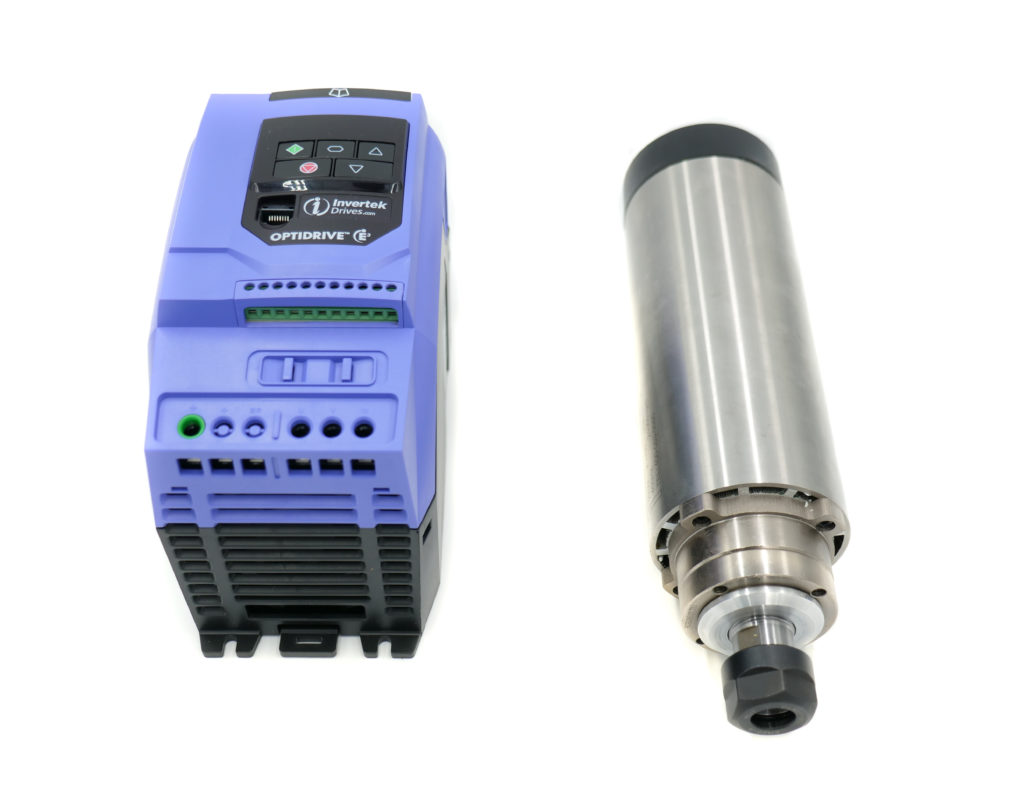Thinking of setting up a VFD Spindle? This blog post is to share information about the important steps to consider when purchasing & configuring VFD Spindle.
Information in this blog post is specific to VFD & spindle motors and their application as it is generally used on small CNC routers. It may or may not be relevant to the equipment you purchase or your use case.
FIRST A Warning!
VFD spindles are not an appliance like a kettle that you just plug in an turn on. They almost always require hard wiring and have seriously dangerous voltages on their inputs and outputs. VFD’s store a large amount of power for a considerable time after they have been powered down. They are to be installed and commissioned by an experienced professional or signed off by electrician. The safety of you and anyone else who comes in contact with this equipment in the future is too important to risk!
Why choose VFD Spindles
VFD spindles are a great alternative to using hand held routers to power your CNC machine. Hand routers are designed for small jobs in your hand not for running for hours on end. Hand routers often handle this unintended workload surprisingly well however they are in almost every way the wrong tool for the job.
VFD Spindles Pros
- Significantly quieter than handheld routers
- Better speed range and availability of collet sizes.
- Much higher duty cycle – they are designed to run all day.
- No brushes to wear out.
- Higher torque in lower speed range
- Considerably better tool runout (accuracy) which leads to higher quality output and longer tool life.
- GCode Control (automatic control from software) – Most often (depending on the CNC controller) you can start/stop and set the speed of the spindle via G-code and also override these speeds from the machine control software in real-time.
VFD Spindle Cons
- Price – doing it right with approved products and licensed installation will absolutely cost 2+ times more than picking up a handheld router and bolting it to a CNC machine.
- Technical to set up – far from plug and play.
- Potentially RF Noisy (electronically not audibly) – Cheap or incorrectly commissioned/programmed VFD’s can send you down a rabbit hole chasing EMF noise-causing all sorts of failures during machining. It’s hard to chase noise without an oscilloscope and training.
Spindle VS Auto Tool Change (ATC) Spindle
Many standard spindles are listed as ATC when buying from overseas (ebay, alibaba etc). If the spindle is not costing you thousands of dollars then it is not ATC.
While an auto tool change is so very desirable – it is expensive and difficult to setup. On top of the ATC spindle you require compressed air, air conditioning equipment, tool holders, tool carousel or similar, additional electronics such as solenoid valves and sensors, ATC functionality in your CNC controller not to mention dedicated space on your machine to store tools. ATC spindles are a good choice 12 months down the road when you have everything else CNC related under control, the business case for going ATC is proven, and you have some $$ and time to spare.
Components in A VFD Spindle Setup.
- VFD (Variable Frequency Drive) also known as VSD (Variable Speed Drive) or an ‘inverter’
- 3 Phase Induction Spindle Motor
- VFD Spindle Cable
- AC Input Cable
- VFD Control Cable
VFD
The VFD is the spindle motor driver. Usually (for our use case) accepts single-phase 50-60HZ AC input from your mains, rectifies it to DC before inverting it back to 3 phases of AC, 120° separated, voltage varied, and at a frequency ranging (generally) from 0 to 400HZ. It is this varying frequency that drives the spindle motor at different speeds. Generally, it is 0 – 400 HZ translating to 0 – 240000 RPM and is fairly linear.
VFD’s are generally still required even if you have 3 phase power available at the site, as the varying frequency part of the drive is required to operate the spindle throughout its nameplate range of RPM. The spindles are usually rated 24000RPM at 400 HZ and so simply connected to a 3 phase 50 HZ supply without VFD it would just spin @ 3000RPM. (50/400*24000)
3 Phase Induction Spindle Motor
The spindle motors are 3 phase induction motors with a collet taper and nut built into the motors output shaft. As described above they do not need 3 phase available to make use of these motors. A correctly selected VFD will drive the 3 phase motor from a single-phase supply without any torque loss.
VFD Spindle Cable
The VFD Cable connects the spindle input to the VFD’s varying output – usually to terminals marked U,V,W, & Ground/Earth. This is no ordinary cable! VFD cables are very specific to their application – you cannot use just any old cable. Chances are if a cable came with your equipment and you didn’t get it from a knowledgable approved supplier of such equipment then it’s not the right part. No CNC machine, spindle or VFD that we have ever seen which was purchased from china or came installed on a machine purchased from china had ever used the appropriate gauge or type of VFD cable – not one – they are generally also not grounded. Sadly a large percentage of locally sourced CNC machines and VFD spindle packages also either are poorly matched, documented, unapproved and generally unsafe due to lack of grounding.
VFD Cable is comparatively expensive – expect to pay anywhere up to $10 per meter for 2.5mm2 4 core cable. It should be heavily shielded with a considerable braid and possibly also foil. Both ends of the shield need to be grounded – this is one of the few times you must terminate both ends of a shielded cable. Again, you cannot use a shielded cable that was not designed for this VFD application and you cannot use a cable that is not shielded, even if it appears to be working at first.
AC Input Cable
This is the AC input power cable for the VFD. The gauge of this wire should be selected with consideration to the nameplate current ratings of the VFD, the circuit the device is being connected to should also be evaluated as to its ability to safely power the device. Your electrician should be capable of ensuring the safe commissioning of this device.
VFD Control Cable
The cable that connects your CNC controller to the VFD to enable on/off and the spindle speed instruction. This should be short, shielded, and not run past the VFD output cable. It’s only a signalling power level requirement so cable cross-section is not usually an issue. A shielded instrument or security cable is sufficient. Maintain the shield intact as close as possible to the termination of both ends of this cable, grounding of one end might be required.
Pre Purchase Considerations
Air Cooled Vs Water Cooled.
While water-cooled spindles will cool more efficiently if they have a large enough reservoir, they are not always and often not the best option.
Consider:
- Cooling fluid plumbed in and around high power electrics can be a safety risk.
- Issues such as pump failure, airlock, pinched hoses, blockages, cavitation, forgetting to turn on etc can all lead to lack of cooling and spindle failure. Failures due to these and other issues are far more prevalent than overworking and damaging an air-cooled spindle.
- Cooling fluids need filtration and periodic replacement.
- While it is true that the water-cooled spindles are quieter than air-cooled, the small additional volume due to the spinning impeller and airflow is fairly quickly muted by the sound of actually machining something.
So unless you are in a tin shed, in mid-summer and intending to operate at production output levels – Air-cooled could be a more effective solution?
Random eBay VFD/VSD/ Inverter VS approved Equipment.
VFDs are like little EMF bombs – even the good ones are generating a good bit of noise. There is allot you can do to dampen the noise emanating from a poor quality VFD system, or you could just replace it with a device approved for use in your region which will most likely emit far less noise. Yes, they are of course going to be more expensive, possibly more than you may have spent on the entire VFD & Spindle set up but they can also be cheaper than the cost of downtime, chasing down issues, or eventually throwing it in the bin and buying a quality product.
Before purchasing a VFD,
- Ask the supplier if the device is approved for use in the region. Random imports most likely are not and should not legally be sold or imported into the region.
- make sure there is an English user manual available, these devices are fairly complex with manuals sometimes several hundred pages long, this manual will be very important.
- Is there local support your electrician can call on during commissioning and programming? Many people have spent more on electricians fees than they would have spent purchasing a locally supported unit.
Spindle Power and Collet Specification
When choosing the spindle, consider:
- What weight will your Z-axis and gantry support – can you put a 7KG 2.2 KW spindle on an X Carve/shapeoko/workbee, no.
- What size tooling will you need to make use of. ER11 Systems will support up to 7mm, ER16 up to 10mm, ER20 up to 13mm
- How much power can you make use of, can you push an X Carve/shapeoko/workbee fast enough to make use of the additional power in a 2.2KW spindle… No other limitations of many lightweight machines will come into play far before you could hope to make use of the extra power.
- What size spindle & VFD can your electrical system support? A 2.2KW 10A spindle is rated 10A at 3 phase – the VFD may draw double or more current on the single-phase powering it so so you couldn’t connect one to a 10 A PowerPoint.
Before purchasing a Spindle:
- is a great time to engage the electrician you will be using for commissioning – they will be able assess your power systems and advise you on the equipment you should purchase.
- Check with the spindle supplier the diameter of the opening on the spindle plug. Many of the cheap spindles use plugs designed for cables so much smaller than the acceptable gauge for such a device. It can be hard work terminating a 12mm diameter cable into a 6mm opening.
Commissioning Considerations
An incomplete list of safety considerations:
- Don’t do this yourself – yes again please get a licensed electrician to commission the device.
- Request your electrician check your spindle is grounded. VFD spindles almost always have a 4 pin plug and socket with 3 active pins and ground (often pin 4). The ground is also almost always not connected to anything inside the spindle – yes this is so incredibly unacceptable… but true. A simple continuity test will determine if there is a connected ground pin. You must not operate an ungrounded spindle, If your spindle is not grounded and the supplier is local, return it to them and buy elsewhere. Otherwise, Air-cooled spindles can be grounded fairly simply – with caution to ensure the wires are kept clear of the impeller when resealing. Water-cooled spindles should be grounded very carefully – on removing the top cover the liquid seal is interrupted and must be carefully reinstalled and pressure tested before use. Look for a local motor rewind/repair company – it should not be an expensive task to have either air-cooled or water-cooled spindles made safe.
- A handy method to ground the VFD cable at the spindle end is to expose a small amount of braided shield before the plug and connect an earthing wire to it using a hose clamp to ensure the entire circumference of the braid is grounded.
- Do not power up an unprogrammed VFD connected to a water-cooled spindle without the coolant system running. If using air-cooled keep an eye on its temperature until the spindle is commissioned. Spindle stopped and spindle running at Zero RPM is sometimes not the same thing. A spindle running at Zero or low RPM could possibly overheat the spindle quickly.
- Do not simply hit run once powered up – there are many very important parameters to set before running the spindle! Such as Number of poles, max voltage, max current, spin-up time, and others. Failure to set all motor replated parameters correctly can damage the spindle very quickly.
- Do not keep trying again to run an inverter that is stopping with errors. Many error conditions if repeated can damage the VFD or spindle.
Functional Considerations:
- Keep the VFD output cable as far away from any USB or VGA cables, if possible they should not cross or run side by side at any point. Failure to do so increases the risk of noise interference.
- Make sure to use VFD specific VFD output cable, & terminate shields on both ends of shielding!!! Failure to do so increases the risk of noise interference.
- If you are using an unshielded limit switch/probe or other IO cables and are experiencing noise-related issues (Disconnects, frozen machine, ghost hard limit or Estop triggers, stepper motors creeping on their own…) one or more of the following may be required:
- Keep the VFD cable away from other unshielded IO cables
- Change IO cables to shielded
- Analyse interference on the IO lines and build a filter specific to the noise
- Use snap on ferrites to choke some of the noise – as close as possible to the connection at the CNC controller or BOB.
- The Spindle must run clockwise when looking from above. If it runs anticlockwise the machine may appear to work (terribly) – don’t forget to check the rotation direction. If the VFD does not have a parameter to reverse the spindle direction you can swap and two of the UV&W cables with each other and the direction will reverse. (This should be done by your electrician while commissioning not by yourself at a later point)
- Consider setting a minimum speed as well as the maximum. Most spindles are 24000 RPM rated (Not All), they are generally not marked with a minimum RPM however operating them at a low speed can cause excessive heat generation. This is more true for Air-cooled spindles where the impeller is connected to the spindle shaft and so cooling is directly linked to speed. Both Water and Air-cooled high-frequency spindles tend to run hot at low RPM. There are not many use cases for running one of these spindles under a couple of thousand RPM so why not set a minimum in the VFD so you can’t accidentally cook the spindle.
- Hookup start/stop and speed-related connections from the CNC controller to the VFD if they are available. The ability to automate spindle start/stop and override speeds mid-job is one of the best features of a VFD spindle. Most VFD does not accept PWM signals which are often the output of basic controllers. 0-10V is the most common input for speed control, with 0 being 0RPM and 10V being full speed. The full speed value can often be reduced if your CNC controller only outputs 5V or 3V as its max speed output – But this does not mean you can use a 5V PWM speed signal without a PWM to Analog converter board or some custom filtering.
- Run the spindle in as per the manufacturers specification before using it to cut under load. If not specified, 5 minutes at 5000, then 10000,15000 and 24000 RPM should help seat the bearings in.
- Consider the fault output of the VFD. Most can be configured to operate an internal relay on a fault which you could possibly connect to an estop or feed hold functionality. Otherwise, a CNC machine will not know if the spindle stopped with an error and would attempt to force a stationary endmill through the job. Not the end of the world but guaranteed destroyed endmill and stock.
- If using a water-cooled spindle, consider having the pump always on when the machine is powered up so that you cannot forget to turn on the cooling. Also, consider a flow alarm that will stop the machine or at least alert you if the cooling system is not flowing.
Conclusion
That was a lot of information, and it all sounds a bit hard however truth be told VFD Spindle systems can be simple and highly reliable. It all hinges on quality tested components and local support.
3DTek supply VFD Spindle packages using quality components that we have been using for years and know how to set up and troubleshoot with minimal difficulty. Our VFD’s alone cost more than some entire VFD & Spindle packages you might find online and this is due to the fact that we cannot legally or morally supply unapproved and often dangerous equipment to our markets and customers. Other than the incomplete, general but hopefully helpful tips in this blogpost – 3DTek are unable to offer support in troubleshooting equipment other than the approved VFD’s we supply – further we can only offer our assistance in commissioning 3DTek supplied equipment directly to or for the purpose of relay to your licensed electrician.


